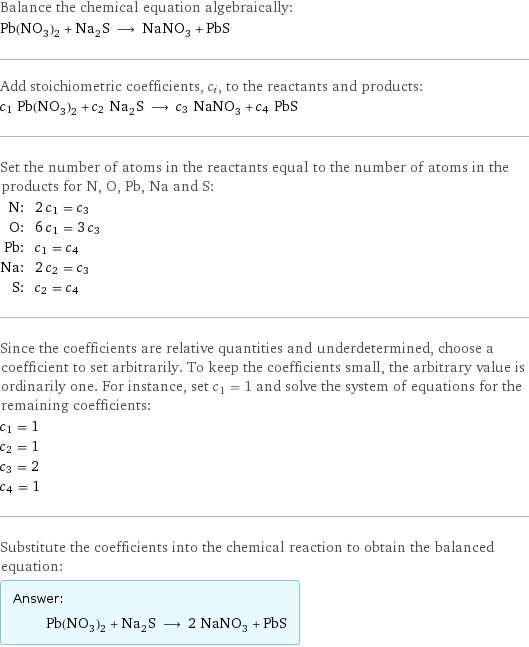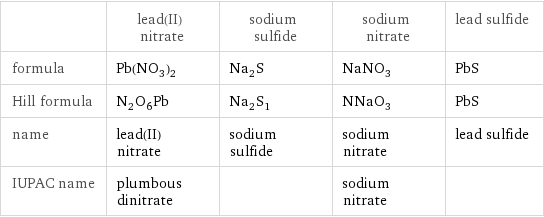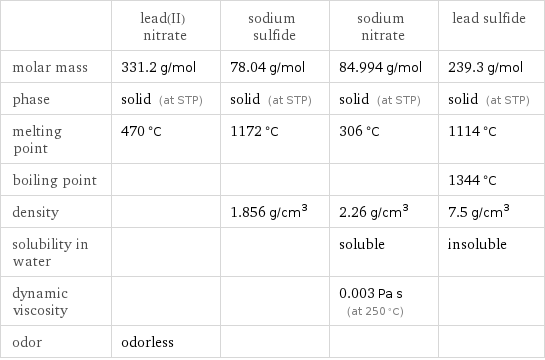Input interpretation

Pb(NO_3)_2 (lead(II) nitrate) + Na_2S (sodium sulfide) ⟶ NaNO_3 (sodium nitrate) + PbS (lead sulfide)
Balanced equation

Balance the chemical equation algebraically: Pb(NO_3)_2 + Na_2S ⟶ NaNO_3 + PbS Add stoichiometric coefficients, c_i, to the reactants and products: c_1 Pb(NO_3)_2 + c_2 Na_2S ⟶ c_3 NaNO_3 + c_4 PbS Set the number of atoms in the reactants equal to the number of atoms in the products for N, O, Pb, Na and S: N: | 2 c_1 = c_3 O: | 6 c_1 = 3 c_3 Pb: | c_1 = c_4 Na: | 2 c_2 = c_3 S: | c_2 = c_4 Since the coefficients are relative quantities and underdetermined, choose a coefficient to set arbitrarily. To keep the coefficients small, the arbitrary value is ordinarily one. For instance, set c_1 = 1 and solve the system of equations for the remaining coefficients: c_1 = 1 c_2 = 1 c_3 = 2 c_4 = 1 Substitute the coefficients into the chemical reaction to obtain the balanced equation: Answer: | | Pb(NO_3)_2 + Na_2S ⟶ 2 NaNO_3 + PbS
Structures

+ ⟶ +
Names

lead(II) nitrate + sodium sulfide ⟶ sodium nitrate + lead sulfide
Reaction thermodynamics
Enthalpy

| lead(II) nitrate | sodium sulfide | sodium nitrate | lead sulfide molecular enthalpy | -451.9 kJ/mol | -364.8 kJ/mol | -467.9 kJ/mol | -100.4 kJ/mol total enthalpy | -451.9 kJ/mol | -364.8 kJ/mol | -935.8 kJ/mol | -100.4 kJ/mol | H_initial = -816.7 kJ/mol | | H_final = -1036 kJ/mol | ΔH_rxn^0 | -1036 kJ/mol - -816.7 kJ/mol = -219.5 kJ/mol (exothermic) | | |
Equilibrium constant
![Construct the equilibrium constant, K, expression for: Pb(NO_3)_2 + Na_2S ⟶ NaNO_3 + PbS Plan: • Balance the chemical equation. • Determine the stoichiometric numbers. • Assemble the activity expression for each chemical species. • Use the activity expressions to build the equilibrium constant expression. Write the balanced chemical equation: Pb(NO_3)_2 + Na_2S ⟶ 2 NaNO_3 + PbS Assign stoichiometric numbers, ν_i, using the stoichiometric coefficients, c_i, from the balanced chemical equation in the following manner: ν_i = -c_i for reactants and ν_i = c_i for products: chemical species | c_i | ν_i Pb(NO_3)_2 | 1 | -1 Na_2S | 1 | -1 NaNO_3 | 2 | 2 PbS | 1 | 1 Assemble the activity expressions accounting for the state of matter and ν_i: chemical species | c_i | ν_i | activity expression Pb(NO_3)_2 | 1 | -1 | ([Pb(NO3)2])^(-1) Na_2S | 1 | -1 | ([Na2S])^(-1) NaNO_3 | 2 | 2 | ([NaNO3])^2 PbS | 1 | 1 | [PbS] The equilibrium constant symbol in the concentration basis is: K_c Mulitply the activity expressions to arrive at the K_c expression: Answer: | | K_c = ([Pb(NO3)2])^(-1) ([Na2S])^(-1) ([NaNO3])^2 [PbS] = (([NaNO3])^2 [PbS])/([Pb(NO3)2] [Na2S])](../image_source/d9f18dd42b39a7c31b1f5f83222dae65.png)
Construct the equilibrium constant, K, expression for: Pb(NO_3)_2 + Na_2S ⟶ NaNO_3 + PbS Plan: • Balance the chemical equation. • Determine the stoichiometric numbers. • Assemble the activity expression for each chemical species. • Use the activity expressions to build the equilibrium constant expression. Write the balanced chemical equation: Pb(NO_3)_2 + Na_2S ⟶ 2 NaNO_3 + PbS Assign stoichiometric numbers, ν_i, using the stoichiometric coefficients, c_i, from the balanced chemical equation in the following manner: ν_i = -c_i for reactants and ν_i = c_i for products: chemical species | c_i | ν_i Pb(NO_3)_2 | 1 | -1 Na_2S | 1 | -1 NaNO_3 | 2 | 2 PbS | 1 | 1 Assemble the activity expressions accounting for the state of matter and ν_i: chemical species | c_i | ν_i | activity expression Pb(NO_3)_2 | 1 | -1 | ([Pb(NO3)2])^(-1) Na_2S | 1 | -1 | ([Na2S])^(-1) NaNO_3 | 2 | 2 | ([NaNO3])^2 PbS | 1 | 1 | [PbS] The equilibrium constant symbol in the concentration basis is: K_c Mulitply the activity expressions to arrive at the K_c expression: Answer: | | K_c = ([Pb(NO3)2])^(-1) ([Na2S])^(-1) ([NaNO3])^2 [PbS] = (([NaNO3])^2 [PbS])/([Pb(NO3)2] [Na2S])
Rate of reaction
![Construct the rate of reaction expression for: Pb(NO_3)_2 + Na_2S ⟶ NaNO_3 + PbS Plan: • Balance the chemical equation. • Determine the stoichiometric numbers. • Assemble the rate term for each chemical species. • Write the rate of reaction expression. Write the balanced chemical equation: Pb(NO_3)_2 + Na_2S ⟶ 2 NaNO_3 + PbS Assign stoichiometric numbers, ν_i, using the stoichiometric coefficients, c_i, from the balanced chemical equation in the following manner: ν_i = -c_i for reactants and ν_i = c_i for products: chemical species | c_i | ν_i Pb(NO_3)_2 | 1 | -1 Na_2S | 1 | -1 NaNO_3 | 2 | 2 PbS | 1 | 1 The rate term for each chemical species, B_i, is 1/ν_i(Δ[B_i])/(Δt) where [B_i] is the amount concentration and t is time: chemical species | c_i | ν_i | rate term Pb(NO_3)_2 | 1 | -1 | -(Δ[Pb(NO3)2])/(Δt) Na_2S | 1 | -1 | -(Δ[Na2S])/(Δt) NaNO_3 | 2 | 2 | 1/2 (Δ[NaNO3])/(Δt) PbS | 1 | 1 | (Δ[PbS])/(Δt) (for infinitesimal rate of change, replace Δ with d) Set the rate terms equal to each other to arrive at the rate expression: Answer: | | rate = -(Δ[Pb(NO3)2])/(Δt) = -(Δ[Na2S])/(Δt) = 1/2 (Δ[NaNO3])/(Δt) = (Δ[PbS])/(Δt) (assuming constant volume and no accumulation of intermediates or side products)](../image_source/e8f604a0644b70c2c07532e30c879463.png)
Construct the rate of reaction expression for: Pb(NO_3)_2 + Na_2S ⟶ NaNO_3 + PbS Plan: • Balance the chemical equation. • Determine the stoichiometric numbers. • Assemble the rate term for each chemical species. • Write the rate of reaction expression. Write the balanced chemical equation: Pb(NO_3)_2 + Na_2S ⟶ 2 NaNO_3 + PbS Assign stoichiometric numbers, ν_i, using the stoichiometric coefficients, c_i, from the balanced chemical equation in the following manner: ν_i = -c_i for reactants and ν_i = c_i for products: chemical species | c_i | ν_i Pb(NO_3)_2 | 1 | -1 Na_2S | 1 | -1 NaNO_3 | 2 | 2 PbS | 1 | 1 The rate term for each chemical species, B_i, is 1/ν_i(Δ[B_i])/(Δt) where [B_i] is the amount concentration and t is time: chemical species | c_i | ν_i | rate term Pb(NO_3)_2 | 1 | -1 | -(Δ[Pb(NO3)2])/(Δt) Na_2S | 1 | -1 | -(Δ[Na2S])/(Δt) NaNO_3 | 2 | 2 | 1/2 (Δ[NaNO3])/(Δt) PbS | 1 | 1 | (Δ[PbS])/(Δt) (for infinitesimal rate of change, replace Δ with d) Set the rate terms equal to each other to arrive at the rate expression: Answer: | | rate = -(Δ[Pb(NO3)2])/(Δt) = -(Δ[Na2S])/(Δt) = 1/2 (Δ[NaNO3])/(Δt) = (Δ[PbS])/(Δt) (assuming constant volume and no accumulation of intermediates or side products)
Chemical names and formulas

| lead(II) nitrate | sodium sulfide | sodium nitrate | lead sulfide formula | Pb(NO_3)_2 | Na_2S | NaNO_3 | PbS Hill formula | N_2O_6Pb | Na_2S_1 | NNaO_3 | PbS name | lead(II) nitrate | sodium sulfide | sodium nitrate | lead sulfide IUPAC name | plumbous dinitrate | | sodium nitrate |
Substance properties

| lead(II) nitrate | sodium sulfide | sodium nitrate | lead sulfide molar mass | 331.2 g/mol | 78.04 g/mol | 84.994 g/mol | 239.3 g/mol phase | solid (at STP) | solid (at STP) | solid (at STP) | solid (at STP) melting point | 470 °C | 1172 °C | 306 °C | 1114 °C boiling point | | | | 1344 °C density | | 1.856 g/cm^3 | 2.26 g/cm^3 | 7.5 g/cm^3 solubility in water | | | soluble | insoluble dynamic viscosity | | | 0.003 Pa s (at 250 °C) | odor | odorless | | |
Units
